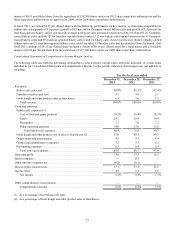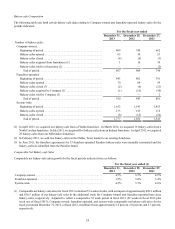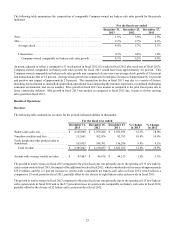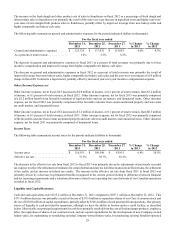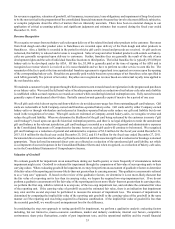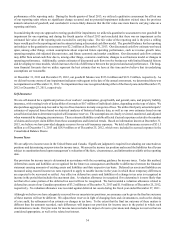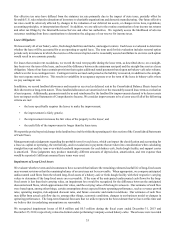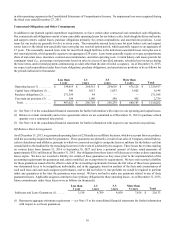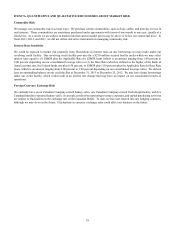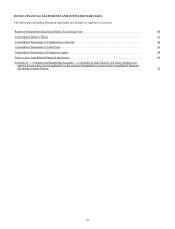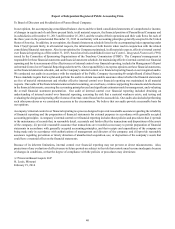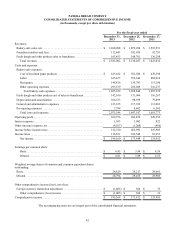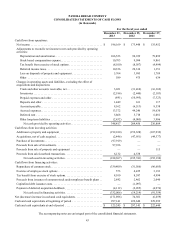Panera Bread 2013 Annual Report Download - page 41
Download and view the complete annual report
Please find page 41 of the 2013 Panera Bread annual report below. You can navigate through the pages in the report by either clicking on the pages listed below, or by using the keyword search tool below to find specific information within the annual report.33
for revenue recognition, valuation of goodwill, self-insurance, income taxes, lease obligations, and impairment of long-lived assets
to be the most critical in the preparation of the consolidated financial statements because they involve the most difficult, subjective,
or complex judgments about the effect of matters that are inherently uncertain. There have been no material changes to our
application of critical accounting policies and significant judgments and estimates that occurred during the fiscal year ended
December 31, 2013.
Revenue Recognition
We recognize revenues from net bakery-cafe sales upon delivery of the related food and other products to the customer. Revenues
from fresh dough and other product sales to franchisees are recorded upon delivery of the fresh dough and other products to
franchisees. Also, a liability is recorded in the period in which a gift card is issued and proceeds are received. As gift cards are
redeemed, this liability is reduced and revenue is recognized. Sales of soup and other branded products sold outside our bakery-
cafes are generally recognized upon delivery to customers. Further, franchise fees are generally the result of the sale of area
development rights and the sale of individual franchise locations to third parties. The initial franchise fee is typically $35,000 per
bakery-cafe to be developed under the ADA. Of this fee, $5,000 is generally paid at the time of signing of the ADA and is
recognized as revenue when it is received as it is non-refundable and we have to perform no other service to earn this fee. The
remainder of the fee is paid at the time an individual franchise agreement is signed and is recognized as revenue upon the opening
of the corresponding bakery-cafe. Royalties are generally paid weekly based on a percentage of net franchisee sales specified in
each ADA (generally five percent of net sales). Royalties are recognized as revenue based on contractual royalty rates applied to
the net franchise sales.
We maintain a customer loyalty program through which customers earn rewards based on registration in the program and purchases
at our bakery-cafes. We record the full retail value of loyalty program rewards as a reduction of net bakery-cafe sales and a liability
is established within accrued expenses as rewards are earned while considering historical redemption rates. Fully earned rewards
generally expire if unredeemed after 60 days. Partially earned awards generally expire if inactive for a period of one year.
We sell gift cards which do not expire and from which we do not deduct non-usage fees from outstanding gift card balances. Gift
cards are redeemable at both Company-owned and franchise-operated bakery-cafes. Gift cards sold by either Company-owned
bakery-cafes or through wholesalers and redeemed at franchise-operated bakery-cafes reduce our gift card liability but do not
result in the recognition of revenue. When gift cards are redeemed at Company-owned bakery-cafes, we recognize revenue and
reduce the gift card liability. When we determine the likelihood of the gift card being redeemed by the customer is remote ("gift
card breakage"), based upon our specific historical redemption patterns, and there is no legal obligation to remit the unredeemed
gift card balance in the relevant jurisdiction, gift card breakage is recorded as a reduction of general and administrative expenses
in the Consolidated Statements of Comprehensive Income; however, such gift cards will continue to be honored. We recognized
gift card breakage as a reduction of general and administrative expenses of $2.8 million for the fiscal year ended December 31,
2013, $1.8 million for the fiscal year ended December 25, 2012, and $1.9 million for the fiscal year ended December 27, 2011.
Incremental direct costs related to the sale of gift cards are deferred until the associated gift card is redeemed or breakage is deemed
appropriate. These deferred incremental direct costs are reflected as a reduction of the unredeemed gift card liability, net which
is a component of accrued expenses in the Consolidated Balance Sheets and, when recognized, as a reduction of bakery-cafe sales,
net in the Consolidated Statements of Comprehensive Income.
Valuation of Goodwill
We evaluate goodwill for impairment on an annual basis during our fourth quarter, or more frequently if circumstances indicate
impairment might exist. Goodwill is evaluated for impairment through the comparison of fair value of our reporting units to their
carrying values. When evaluating goodwill for impairment, we may first perform an assessment of qualitative factors to determine
if the fair value of the reporting unit is more-likely-than-not greater than its carrying amount. This qualitative assessment is referred
to as a “step zero” approach. If, based on the review of the qualitative factors, we determine it is not more-likely-than-not that
the fair value of a reporting unit is less than its carrying value, we bypass the required two-step impairment test. If we do not
perform a qualitative assessment or if the fair value of the reporting unit is not more-likely- than-not greater than its carrying value,
we perform the first step, which is referred to as step one, of the two-step impairment test, and calculate the estimated fair value
of the reporting unit. If the carrying value of goodwill exceeds the estimated fair value, there is an indication that impairment
may exist and the second step must be performed to measure the amount of impairment loss. The amount of impairment is
determined by comparing the implied fair value of the reporting unit goodwill to the carrying value of the goodwill in the same
manner as if the reporting unit was being acquired in a business combination. If the implied fair value of goodwill is less than
the recorded goodwill, we would record an impairment loss for the difference.
In considering the step zero approach to testing goodwill for impairment, we perform a qualitative analysis evaluating factors
including, but not limited to, macro-economic conditions, market and industry conditions, internal cost factors, competitive
environment, share price fluctuations, results of past impairment tests, and the operational stability and the overall financial


